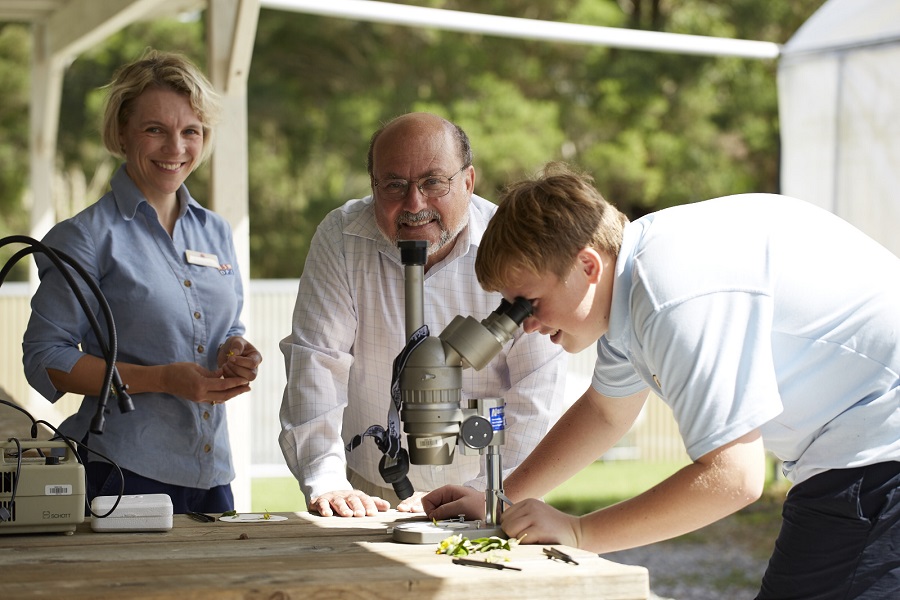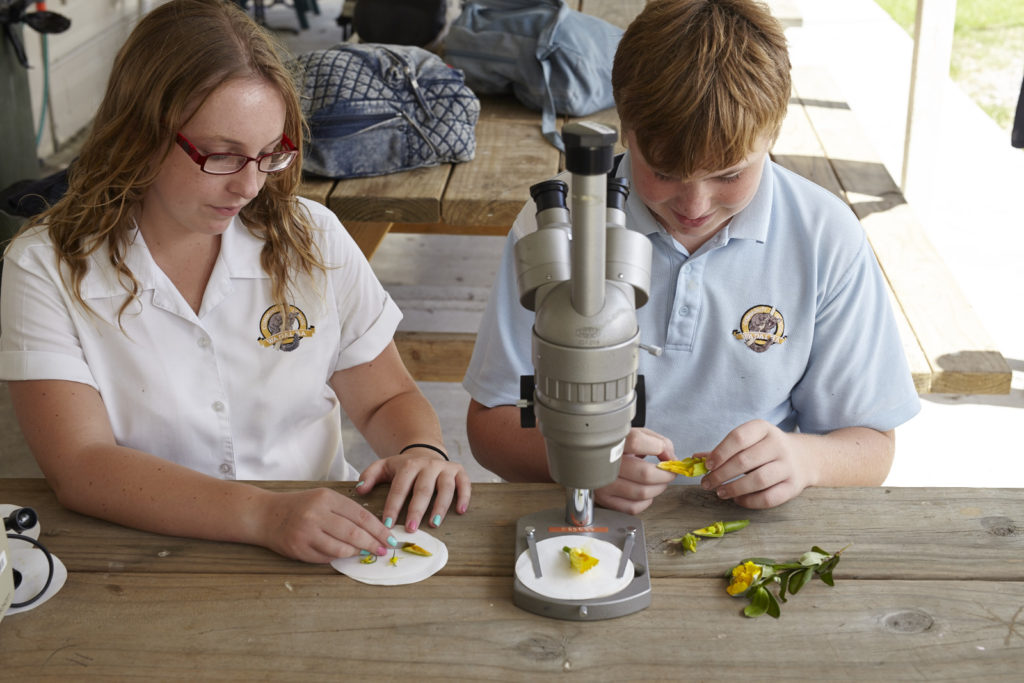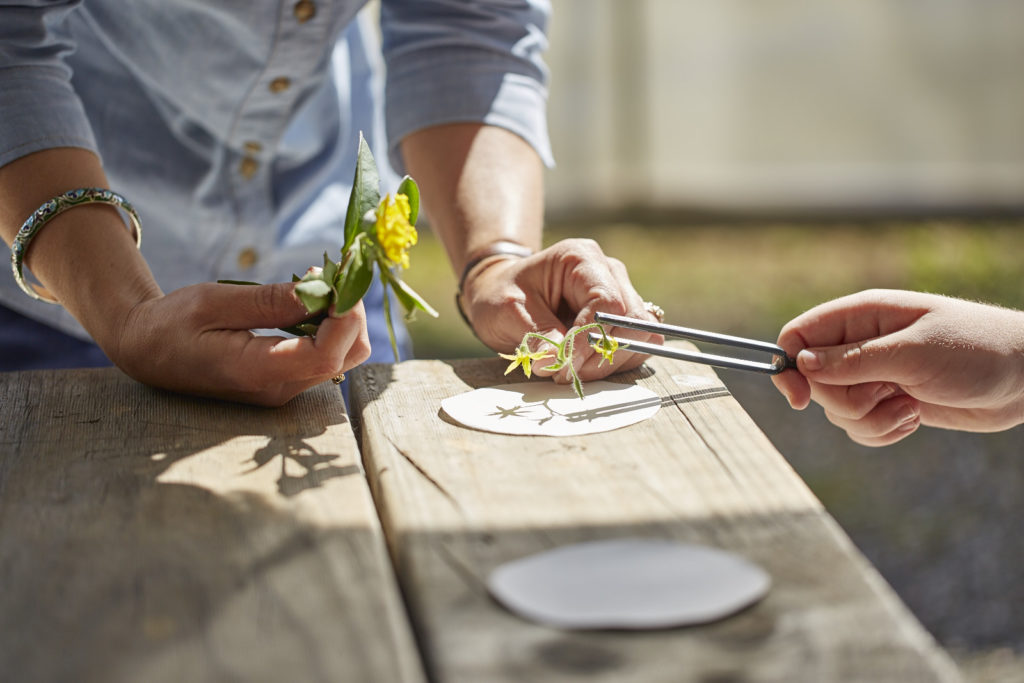Our SMiS program is helping to build interest, confidence, creativity and out-of-the-box thinking for students in STEM.

Dr Sophie Parks and Mr Frank Soreca watching a student view a plant through a microscope during a science lesson
Dr Sophie Parks bringing STEM subjects to life in Mr Soreca’s science classroom at Wadalba Community School
Getting students excited about specialised subjects at school can sometimes be a tough slog. Most of us can recall going to class and wondering why we have to make a battery out of lemons or dissect a frog. But helping students understand their relevance and apply science, technology, engineering and maths (STEM) can build interest, confidence, creativity and out-of-the-box thinking.
The STEM subjects we learn at school are not just useful if you want to pursue a career in science, technology, engineering and maths, they’re essential to fostering innovation and critical thinking – a recent report from Australia’s Chief Scientist highlighted this. Yet, student participation in STEM subjects is declining and this means Australia is lagging behind.
Today, 11 percent fewer year 12 students study maths than in 1992, the overall number of year 12 students studying STEM subjects is also declining, and there is a 35 percent drop in enrollment in information tech subjects in universities since 2001.
But the outlook isn’t all grim. There are a number of education outreach programs that are getting students interested in STEM and making a positive impact on engagement levels in the classroom. And not to toot our own horn, but we’ve been doing that for more than 30 years.
STEM professionals go back to school
Our Scientists and Mathematicians in Schools (SMiS) is an example of a program that is tackling this challenge. This program involves a STEM professional heading back to school to bring to life what they do and why they do it. While there is never an average day for a SMiS partnership, it’s pretty flexible and covers a variety of subject matters and activities that are aligned to the Australian Curriculum.
Making the grade
A report by Deakin University released today Building Productive Partnerships for STEM Education: Evaluating the model and outcomes of the Scientists and Mathematicians in Schools program 2015 highlights that collaborative partnership programs like SMiS mean students are more interested and getting better results in STEM subjects. In fact, the report found that 79 percent of teachers nominated an increase in student’s engagement with science and 60 percent nominated improved learning of science by students in the classroom as pretty positive changes that would not have occurred, if not for the SMiS program! And it’s because professionals in partnership with teachers bring STEM subjects to life in the classroom.
Some additional points of interest include:
- 4,600 partnerships have been formed over 8 years of the program
- Currently 1,263 schools and over 60,000 students are involved in the program across Australia per year
- Leverages almost 3 x annual funding in terms of time volunteered by STEM professionals
- A collaborative partnership was considered very valuable to 62 percent science teachers and 69 percent of their students
On the honour roll
Students at Wadalba Community School in New South Wales, have experienced first-hand what it’s like to have a scientist in the classroom. Dr Sophie Parks, is a research scientist at the NSW Department of Primary Industries and hosts horticultural class excursions at the Primary Industries Centre, as well as giving classroom talks about plant biology. Showing students why bee pollination is important for plants was an experiment that engaged everyone in class.

Two students are sitting at a table doing a classroom science experiment. The female student on the right is looking at the pollen of a plant on a circular white sheet of paper. The male student on the left has a microscope in front of him and he is prepping a plant to view under the microscope.
CSIRO SMiS helps to pollinate ideas in the classroom
According to Frank Soreca and David Drury, two of Wadalba’s science and agriculture teachers, bringing Dr Parks into the classroom gives their students access to resources and information about science that shows it being applied in the everyday world with exciting career paths to match.

A scientist is bending over a table that has a pollination experiment on it. She is holding a plant while a student is holding up an instrument tuner near the plant to replicate pollination.
Bee-ing scientific in the classroom can be fun!
Making STEM cool for school
Active partnerships make a real and positive impact on how students learn. There are lots of engaging ways teachers and volunteer STEM professionals can work together and sometimes that can be really different and engaging. From a geophysicist helping a year 4 girls class build a rocket, to a beach excursion where students can learn about ocean ecology, STEM professionals are helping them to apply scientific inquiry to what they do in and out of the classroom.
SMiS program director, Claudette Bateup, says the importance and impact of student engagement cannot be underestimated in effective STEM education; without students being ‘switched on’ to learning, the opportunity for growing Australia’s STEM capacity is limited at best.
“SMiS Professional partnerships help make science and STEM subjects real. By changing perceptions of what a STEM professional is and what they do, they help students create new identities around what a STEM professional actually is and does, making the skills and careers relevant for young and curious minds.”
You can download the Executive Summary here.
The program is funded by the Australian Government and CSIRO, and managed by CSIRO.
For media queries, please contact Ofa Fitzgibbons ofa.fitzgibbons@csiro.au

